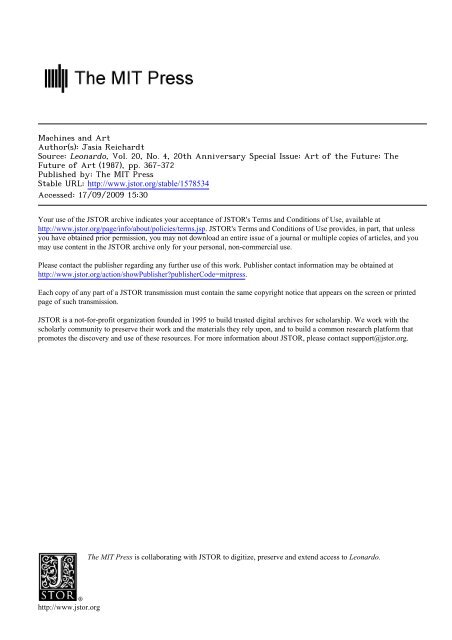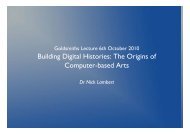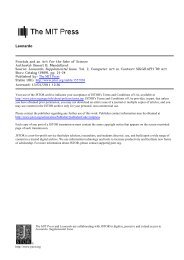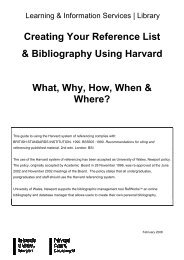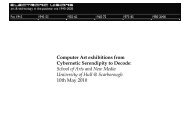Machines and Art â Jasia Reichardt - Computer Arts Society
Machines and Art â Jasia Reichardt - Computer Arts Society
Machines and Art â Jasia Reichardt - Computer Arts Society
You also want an ePaper? Increase the reach of your titles
YUMPU automatically turns print PDFs into web optimized ePapers that Google loves.
<strong>Machines</strong> <strong>and</strong> <strong>Art</strong><br />
Author(s): <strong>Jasia</strong> <strong>Reichardt</strong><br />
Source: Leonardo, Vol. 20, No. 4, 20th Anniversary Special Issue: <strong>Art</strong> of the Future: The<br />
Future of <strong>Art</strong> (1987), pp. 367-372<br />
Published by: The MIT Press<br />
Stable URL: http://www.jstor.org/stable/1578534<br />
Accessed: 17/09/2009 15:30<br />
Your use of the JSTOR archive indicates your acceptance of JSTOR's Terms <strong>and</strong> Conditions of Use, available at<br />
http://www.jstor.org/page/info/about/policies/terms.jsp. JSTOR's Terms <strong>and</strong> Conditions of Use provides, in part, that unless<br />
you have obtained prior permission, you may not download an entire issue of a journal or multiple copies of articles, <strong>and</strong> you<br />
may use content in the JSTOR archive only for your personal, non-commercial use.<br />
Please contact the publisher regarding any further use of this work. Publisher contact information may be obtained at<br />
http://www.jstor.org/action/showPublisher?publisherCode=mitpress.<br />
Each copy of any part of a JSTOR transmission must contain the same copyright notice that appears on the screen or printed<br />
page of such transmission.<br />
JSTOR is a not-for-profit organization founded in 1995 to build trusted digital archives for scholarship. We work with the<br />
scholarly community to preserve their work <strong>and</strong> the materials they rely upon, <strong>and</strong> to build a common research platform that<br />
promotes the discovery <strong>and</strong> use of these resources. For more information about JSTOR, please contact support@jstor.org.<br />
The MIT Press is collaborating with JSTOR to digitize, preserve <strong>and</strong> extend access to Leonardo.<br />
http://www.jstor.org
<strong>Machines</strong> <strong>and</strong> <strong>Art</strong><br />
<strong>Jasia</strong> <strong>Reichardt</strong><br />
Abstract-Since there is no cure for progress, we may assume that machines will play an<br />
increasingly significant role in every area of our lives. <strong>Art</strong>ists have celebrated machines since<br />
they came into existence, first by depicting them <strong>and</strong> more recently by using them as tools <strong>and</strong><br />
assistants. What will happen when machines make their own art? Will we recognise it <strong>and</strong> will we<br />
accept it?<br />
In one version of Sentimental Education,<br />
Flaubert introduces an idea for a heroic<br />
picture which will represent the republic,<br />
or progress, or civilisation, or all three. It<br />
will depict the figure of Christ surmounting<br />
a locomotive which drives over a<br />
virgin forest; here the machine will sweep<br />
through the world under the auspices of<br />
the highest authority. This image of the<br />
machine as an unstoppable force is<br />
prophetic of our contemporary world.<br />
Today, its status <strong>and</strong> influence, its surge<br />
through the 'virgin forest', have become<br />
gauges of our society's progress. Recognition<br />
of the machine's importance is<br />
demonstrated in the existence of an<br />
exp<strong>and</strong>ing generation gap (what the<br />
young know <strong>and</strong> the old do not); in new<br />
toys (unfamiliar to anyone whose childhood<br />
was more than 10 years ago); in<br />
science fiction; in what <strong>and</strong> how people<br />
study; in what <strong>and</strong> how writers write <strong>and</strong>,<br />
of course, in art.<br />
<strong>Art</strong>ists have contributed significantly<br />
to the current image <strong>and</strong> meaning of the<br />
machine <strong>and</strong> have even anticipated some<br />
of its developments. Their approaches to<br />
the subject have ranged from reactionary<br />
distaste, to empathetic ingenuity, to<br />
romantic <strong>and</strong> celebratory bravado. The<br />
machine's role as a metaphor for labour<br />
has been largely ignored by artists.<br />
Rather, it has become a metaphor for the<br />
world itself <strong>and</strong> one that has flowered<br />
through a greater variety of interpretations<br />
than in any other field of our<br />
culture. The Futurists' rapturous endorsement<br />
of the machine is part of<br />
history. Among other celebrated characterisations<br />
the machine has appeared as<br />
a nostalgic object, as an instrument of<br />
erotic longing <strong>and</strong> as an emblem of<br />
human transgressions.<br />
In the world of the imagination, the<br />
<strong>Jasia</strong> <strong>Reichardt</strong> (writer), 12 Belsize Park Gardens,<br />
London NW3 4LD, U.K.<br />
Received 15 September 1986.<br />
(A) Contact with Outer Wori(l.<br />
O)ther Planets.<br />
Futulre.<br />
Women.<br />
A QUIET LUNCH AT HOME.<br />
(H) Communication<br />
India.<br />
NeNws.<br />
Law ('ouirts.<br />
(c) Wireless Broadcast Liglit Screens.<br />
withl U.S.A. <strong>and</strong><br />
A i r Transport.<br />
Submarine Transport.<br />
I lternational Parliamenet.<br />
Fig. 1. A.M. Low, A Quiet Lunch at Home, 1925. This room of the future was devised by the English<br />
inventor <strong>and</strong> writer A.M. Low. Presumably the food is in liquid form since the man in the armchair is<br />
sucking at a pipe coming out of the wall. The room contains everything that the leisured classes of the<br />
future might be expected to require: a large TV screen <strong>and</strong> the means of contacting the outer world<br />
including other planets, the international parliament <strong>and</strong>, somewhat surprisingly, women. The garage<br />
contains a machine that is something between a helicopter <strong>and</strong> a submarine. Note that there is no art in<br />
this room.<br />
machine can <strong>and</strong> often does remain 'an ture, it has been everything from a robot<br />
elusive, half-defined presence. In litera- to a shapeless thing with fictitious<br />
? 1987 ISAST<br />
Pergamon Journals Ltd.<br />
Printed in Great Britain.<br />
0024-094X/87 $3.00+0.00<br />
LEONARDO, Vol. 20, No. 4, pp. 367-372, 1987
functions. Pataphysical machines [1]<br />
would be difficult to reconstruct since<br />
nobody knows precisely how they do<br />
what they do, or what that is anyway. The<br />
comparatively concrete form of machines<br />
in art does not mean that they have been<br />
any more conventional, predictable or<br />
comprehensible. Take, for example,<br />
Francis Picabia's Amorous Parade (1917)<br />
or Girl Born without a Mother (c. 1916-<br />
1918). Referring to Picabia, Paul B.<br />
Havil<strong>and</strong> wrote in 1915:<br />
Man made the machine in his own<br />
image. She has limbs which act; lungs<br />
which breathe; a heart which beats; a<br />
nervous system through which runs<br />
electricity. The phonograph is the<br />
image of his voice; the camera the<br />
image of his eye. The machine is his<br />
'daughter without a mother' [2].<br />
Picabia himself wrote that very year:<br />
The machine has become more than a<br />
mere adjunct of life. It is really a part of<br />
human life ... perhaps the very soul. In<br />
seeking forms through which to<br />
interpret ideas or by which to expose<br />
human characteristics I have come at<br />
length upon the form which appears<br />
most brilliantly plastic <strong>and</strong> fraught with<br />
symbolism. I have enlisted the<br />
machinery of the modern world, <strong>and</strong><br />
introduced it into my studio [3].<br />
Others transformed the machine more<br />
radically. There are, after all, no laws<br />
governing the machine in art, no logic.<br />
Who is to say what the machine should<br />
be?<br />
Marcel Duchamp's Large Glass: The<br />
Bride Stripped Bare by Her Bachelors,<br />
Even (1915-23) was a thoroughly<br />
organised affair, a machine-cum-metaphor<br />
for efficiently controlled passion.<br />
With Max Ernst the machine was given<br />
visibly, rather than functionally, human<br />
attributes-she became a beautiful <strong>and</strong><br />
mysterious <strong>and</strong>roid. She contained all the<br />
insignia of machine essence (typical of the<br />
nineteenth rather than the twentieth<br />
century): cogs <strong>and</strong> wheels, pendula,<br />
pistons, motors, electrical valves. In the<br />
majority of images the machine represented<br />
or symbolised a human being,<br />
but in the works of George Grosz <strong>and</strong><br />
John Heartfield it stood for power, for<br />
the blind force of dictatorship. Other<br />
works, like those of Cesar Domela<br />
Nieuwenhuis, were compared to machines<br />
because, like them, they too could be<br />
assembled <strong>and</strong> taken apart. These had<br />
nothing to do with the machine as a<br />
metaphor. The Purists claimed that<br />
painting is a machine for the transmission<br />
of feelings, but their critics hastened to<br />
dismiss this heroic claim <strong>and</strong> to compare<br />
Fig. 2. Martin Riches, Rotater, walking machine constructed of mixed media, 35 cm high, 1978.<br />
Riches, an Englishman living in Berlin, is a maker of machines that walk, paint, play music <strong>and</strong> provide<br />
bursts of percussion. They are elegant <strong>and</strong> witty <strong>and</strong> sometimes mimic human movements <strong>and</strong> sounds.<br />
This walking machine moves with gentle, delicate steps.<br />
their works to machines that have not reckoned with. Its passionate defender,<br />
even been started up.<br />
Lewis Mumford, believed that "in art it<br />
Whatever the point of view, the was to extend <strong>and</strong> deepen man's original<br />
machine was discussed fervently by all functions <strong>and</strong> institutions". He went<br />
those who recognised it as a force to be on:<br />
368<br />
<strong>Reichardt</strong>, <strong>Machines</strong> <strong>and</strong> <strong>Art</strong>
Fig. 3. Martin Riches, Four-Piece Percussion Installation, mixed media, 2 m high, 1984. When<br />
installed, the assembly occupies a space measuring 7 x 7 m-too large for an average domestic interior.<br />
Our capacity to go beyond the machine<br />
rests upon our power to assimilate the<br />
machine. Until we have absorbed the<br />
lessons of objectivity, impersonality,<br />
neutrality, the lessons of the mechanical<br />
realm, we cannot go further in our<br />
development towards the more richly<br />
organic, the more profoundly human<br />
[4].<br />
Mumford felt that the essential qualities<br />
of the machine-precision, calculation,<br />
flawlessness, simplicity <strong>and</strong> economycould<br />
add emphasis to human instinctive<br />
desire for order <strong>and</strong> organisation. In his<br />
view it was Constantin Brancusi, rather<br />
than either Duchamp or Ernst, who gave<br />
the machine its most brilliant interpretation-in<br />
his use of form, method <strong>and</strong><br />
respect for materials. To Mumford,<br />
Brancusi's bird had the perfection of a<br />
piston.<br />
The prototypical, classical, efficient,<br />
mechanical machine was contradicted<br />
not only by the surrealists but also by the<br />
majority of artists who were to follow. Its<br />
role became twofold. On the one h<strong>and</strong>, it<br />
became the means of expression, a heroic<br />
piece of extravaganza in its own right, a<br />
celebration of machine-hood. On the<br />
other h<strong>and</strong>, it replaced the artists' tools.<br />
In this first instance, as in the work of<br />
Jean Tinguely, it provided the form that<br />
encapsulated the very meaning of the<br />
work-a machine made of machine parts.<br />
Today, the emphasis tends to be different.<br />
The prototypical contemporary machine<br />
does not lend itself to an imaginative<br />
pictorial treatment because it is ultimately<br />
a black box. Today, many artists working<br />
with machines use them not for what they<br />
are but for what they can do. That is why<br />
the most impressive, <strong>and</strong> the most<br />
notorious, prototypical art machine of<br />
the twentieth century (in this first<br />
'expressive' category) is still Tinguely's<br />
Homage to New York, which set itself<br />
alight <strong>and</strong> shook itself to pieces outside<br />
the Museum of Modern <strong>Art</strong> in 1960. Its<br />
spectacular demise accompanied by<br />
explosions <strong>and</strong> fireworks came to an<br />
untimely end within 28 minutes through<br />
the intervention of the fire brigade.<br />
Tinguely called it 'metallic suicide'. None<br />
of his numerous spectacular machines<br />
made since then have done anything so<br />
drastic. The emphasis has been more on<br />
the production of machine-painted<br />
pictures or on machines that play ball<br />
with visitors or go through routines of<br />
energetic movements to the accompaniment<br />
of clanging <strong>and</strong> whirring-a visual<br />
<strong>and</strong> an acoustic synthesis.<br />
All of Tinguely's vivacious machines<br />
are constructed of used metallic parts.<br />
They are sharp in every sense of the<br />
word. By contrast, Claes Oldenburg's<br />
machines seem lazy <strong>and</strong> rounded.<br />
Tinguely invents new machines, Oldenburg<br />
emasculates existing ones. Oldenburg's<br />
machines are recognisable as<br />
machines from the real world, but they<br />
consist of kapok-filled shiny plastic. Soft<br />
telephones <strong>and</strong> soft plugs were followed<br />
by a typewriter pie, soft toaster, soft light<br />
switch, soft fan <strong>and</strong> soft mixer. All these<br />
are literally soft. Softness is not a<br />
prerogative of kapok-some machines<br />
have a soft character. Edward Kienholz's<br />
Friendly Grey <strong>Computer</strong> (1965) is a soft<br />
machine-a spiritually soft machineeven<br />
though its exterior belies its<br />
paradoxical character. This computer-a<br />
square box-sits on a rocking-chair base<br />
<strong>and</strong> answers YES <strong>and</strong> NO to questions<br />
from the public if it is not too tired or if it<br />
is not sulking. Rocking the computer is<br />
advised to restore its energy <strong>and</strong> good<br />
humour.<br />
Clearly Kienholz does not envisage<br />
machines, especially intelligent machines,<br />
as reliable, predictable or useful, <strong>and</strong><br />
there are plenty of precedents for his<br />
attitude. Nor did the makers of the largest<br />
<strong>and</strong> the most famous exhibition robot<br />
(the giant Electro) at the New York<br />
World's Fair in 1939 think of the machine<br />
as utilitarian. The robot demonstrated a<br />
new range of activities available to the<br />
modern machine. He smoked, sang,<br />
counted <strong>and</strong> danced. Electro was never<br />
depicted behind a desk or in a factory. He<br />
became an advocate of leisure like the<br />
new automated kitchen in which nobody<br />
had to do anything, shown at the same<br />
<strong>Reichardt</strong>, <strong>Machines</strong> <strong>and</strong> <strong>Art</strong> 369
Fig. 4. Richard Kriesche, World Model, two industrial robots which repeat identical movements in turn, 1986. (Photo: <strong>Jasia</strong> <strong>Reichardt</strong>) There are many<br />
parallels between the actions of the robots <strong>and</strong> human actions, <strong>and</strong> Kriesche's metaphor is highly apposite.<br />
Fair. This new kitchen was demonstrated<br />
in all its automatic detail to the<br />
amazement of one <strong>and</strong> all, but it was<br />
never manufactured. Its true utilitarian<br />
possibilities were also ultimately limited.<br />
The kitchen was a machine in its own<br />
right: like a sculpture by Tinguely, it<br />
represented the fantasy of its makers; but<br />
rather than an object or a sculpture, it was<br />
an environment. Everything in the<br />
kitchen was timesaving <strong>and</strong> fully automated.<br />
The idea was that the lady of the<br />
house need do no more than press a few<br />
buttons. There were buttons for selecting<br />
a recipe, for mixing the ingredients, for<br />
cooking them, etc. Prepared food was not<br />
shown, but the sounds issuing from<br />
various parts of the room suggested that<br />
something was happening. The newsreel<br />
commentary about the kitchen made it<br />
clear that no cooking skills were<br />
necessary <strong>and</strong> that the hostess, who wore<br />
a cocktail dress, had no need of an apron.<br />
The price of the kitchen included a parttime<br />
salary for an engineer, <strong>and</strong> maybe<br />
this, finally, was the reason the kitchen<br />
was never built. Interestingly enough,<br />
though there were other comparable<br />
futuristic environments, none included<br />
any art, as if their electronic complexity<br />
was in itself sufficient to stimulate the<br />
mind <strong>and</strong> to stir the spirit. In the best<br />
avant-garde tradition, they were new <strong>and</strong><br />
experimental works of art in their own<br />
right.<br />
In 1925, the English inventor <strong>and</strong><br />
writer A.M. Low published a book on the<br />
future [5] in which he included a picture<br />
of a comprehensively furnished room<br />
depicting a man <strong>and</strong> a child at leisure. The<br />
picture is entitled A Quiet Lunch at Home<br />
(Fig. 1). The man is sitting in a deep<br />
armchair <strong>and</strong> sucking at a tube which<br />
issues from a wall. The boy, crouching on<br />
the floor, wears a helmet <strong>and</strong> watches a<br />
Fig. 5. Harold Cohen's program AARON is capable of producing series of varied but related drawings,<br />
reminiscent of Cohen's own paintings of the early 1960s. This drawing was produced in 1983, when<br />
AARON was 10. (Photo: Becky Cohen)<br />
370<br />
<strong>Reichardt</strong>, <strong>Machines</strong> <strong>and</strong> <strong>Art</strong>
Fig. 6. AARON, Black <strong>and</strong> White Drawing, Indian ink on paper, 22 x 30 in, 1986. (Photo: Becky<br />
Cohen) AARON is now 14. His new drawings are more figurative, like this one. He is still deeply<br />
influenced by Harold Cohen, his creator <strong>and</strong> teacher.<br />
mechanical cat chasing a mechanical<br />
mouse. The room, judging by the<br />
positions of the two humans, is extremely<br />
small for a futuristic fantasy-no larger<br />
than 10 X 15 feet, with a television screen<br />
occupying one entire wall. Other objects<br />
in the room include a clock, a gramophone,<br />
a ventilator <strong>and</strong> several communications<br />
panels which not only<br />
facilitate contact with the outer world,<br />
other planets <strong>and</strong> international parliament<br />
but also with 'the future' <strong>and</strong><br />
'women'! The interior is decidedly<br />
crowded. Forty years later, pictures in<br />
the popular <strong>and</strong> architectural press<br />
showed futuristic environments more<br />
sparsely furnished-one piece of furniture<br />
might have been a bed as well as a settee<br />
<strong>and</strong> a light source-<strong>and</strong> these interiors<br />
tended to have curved walls. They too<br />
had consoles with buttons to be pressed<br />
for projecting images, playing music <strong>and</strong><br />
external communications. Unlike in the<br />
room by A.M. Low, there were no toys,<br />
no children <strong>and</strong> nobody over the age of<br />
35. Again there was no art <strong>and</strong> there were<br />
no books, but the difference between<br />
1925 <strong>and</strong> 1965 was that the habitats<br />
depicted in 1965 were designed by artists<br />
<strong>and</strong> architects <strong>and</strong> not by builders or<br />
inventors. <strong>Art</strong> <strong>and</strong> non-art seemed to<br />
become increasingly interchangeable, <strong>and</strong><br />
so there seemed little point in incorporating<br />
art into something that in so<br />
many ways already was a work of art.<br />
This suggests an interesting problem. If<br />
future environments have no art, where<br />
should future art be housed? One assumes<br />
that future art would involve technologies<br />
similar to those of the environments<br />
themselves <strong>and</strong> would inevitably include<br />
machines.<br />
The only obvious conclusion is that<br />
machine art must be destined for the<br />
museum because futuristic interiors have<br />
made no provision for it. The walking<br />
<strong>and</strong> music-playing sculptures of<br />
Englishman Martin Riches will have to<br />
confine themselves either to galleries or to<br />
the stage. The personalities with which<br />
they are endowed suggest that they<br />
belong to a generation after Tinguely's<br />
machines. They produce their own music,<br />
which they sometimes play together with<br />
human musicians. For this they require a<br />
spacious <strong>and</strong> a neutral setting. They<br />
include percussion installations, music<br />
machines, drawing machines <strong>and</strong> walking<br />
machines. Each category is distinctive.<br />
One walking machine, the Rotater, has a<br />
body that revolves around its own axis<br />
<strong>and</strong> takes small delicate steps (Fig. 2).<br />
Another moves forward like a person on<br />
crutches <strong>and</strong> still another like a caterpillar.<br />
The music machines do not always<br />
play melodies. One, for instance, is a<br />
clicking machine with ratchet wheels<br />
which provide 16 rhythmic possible<br />
combinations. The machine selects seven<br />
at r<strong>and</strong>om with each change announced<br />
by a loud click. The final click is followed<br />
by a coda.<br />
The machine-sculptures by Martin<br />
Riches are like performers (Fig. 3);<br />
Richard Kriesche's machine-sculpture<br />
WorldModelis like a metaphorical clock.<br />
It consists of two industrial robots which<br />
alternately perform identical tasks (Fig.<br />
4). As each robot completes a series of<br />
movements, it presses a button which<br />
activates the second robot which, in turn<br />
launches into the same routine. This<br />
continues indefinitely. WorldModel refers<br />
to two things. First, the activity is without<br />
visible purpose. Second, Kriesche reminds<br />
us through the repetitive actions of the<br />
robots that life is made up of the same<br />
rituals, endlessly repeated. They appear<br />
different because they are done by<br />
different groups of individuals <strong>and</strong><br />
because the memory of those who<br />
theoretically could remember blurs with<br />
time.<br />
Most art machines are the artists'<br />
assistants <strong>and</strong> must perform in a manner<br />
prescribed by their makers. In the case of<br />
Harold Cohen, the machine changes its<br />
status by becoming a student with his/her<br />
own incipient ideas. In this instance, it is<br />
the machine, or rather the program, that<br />
is learning to produce works of art.<br />
Cohen's program, AARON, has passed<br />
through various developments during the<br />
past 14 years <strong>and</strong> is now capable of<br />
producing drawings, one after another, of<br />
considerable variety <strong>and</strong> interest (Fig. 5).<br />
While a pen-holding cart manoeuvres<br />
about a large sheet of paper, its position<br />
<strong>and</strong> information about the placing of<br />
lines are continuously fed back to the<br />
computer. The program assesses what<br />
has been done <strong>and</strong> either continues or<br />
finishes the drawing. Each picture has a<br />
discernible character in the disposition of<br />
forms as well as in their complexity <strong>and</strong><br />
their density. Sometimes AARON's<br />
pictures are crowded, sometimes they are<br />
surprisingly sparse. The program incorporates<br />
information about the laws of<br />
perspective <strong>and</strong> various technical constraints,<br />
e.g. that a line/shape hidden<br />
behind another shape must be invisible.<br />
AARON's output is clearly recognisable<br />
as the work of an individual producing a<br />
series of variations on a theme. AARON<br />
is young-only 14-but, even though 14<br />
years is a long span in machine-time, he is<br />
so far the sole exponent of the group that<br />
could be said to be producing its own<br />
pictures. To my knowledge, no other art<br />
students exist in this category.<br />
AARON's pictures are made according<br />
to human aesthetic criteria. Some of them<br />
are almost figurative (Fig. 6). Whatever<br />
his future, AARON is still entirely under<br />
the influence of his professor <strong>and</strong> what is<br />
currently the lingua franca in Western<br />
late twentieth-century art. We can only<br />
assume that in due course machines may<br />
decide to produce their own machine art,<br />
<strong>and</strong> incorporating images of machines or<br />
their programs could be the first sign of<br />
<strong>Reichardt</strong>, <strong>Machines</strong> <strong>and</strong> <strong>Art</strong> 371
their self-interest. Taking this possibility<br />
to a logical conclusion, humans face a<br />
problem. How will they be able to<br />
recognise what, among all the machineproduced<br />
works, is a real work of art<br />
according to machine criteria? M.J.<br />
Rosenberg has given some considerable<br />
thought to this problem in his book The<br />
Cybernetics of <strong>Art</strong>: Reason <strong>and</strong> the<br />
Rainbow [6]. His solution is that one<br />
would have to get another similar<br />
machine to evaluate the products of the<br />
first machine which claims to be<br />
producing works of art. The first machine<br />
must not be aware that it is being assessed<br />
by the second lest it try to please by<br />
producing works of the sort that might be<br />
thought fashionable or indulge in some<br />
jokes that the human observers may not<br />
underst<strong>and</strong>. In these circumstances, it<br />
would be best for humans to become<br />
meta-observers <strong>and</strong> solely to watch the<br />
reactions of the second machine. This<br />
procedure would enable humans to<br />
discover if the works of the first machine<br />
were indeed works of art. The author of<br />
this thesis does not discuss the possibility<br />
that the second machine could either lie<br />
when making its evaluation or assure us<br />
that something is art when it is not, for<br />
fear of being misunderstood or of causing<br />
disappointment to its human audience.<br />
<strong>Machines</strong> too may have problems in<br />
deciding where art ends <strong>and</strong> environment<br />
starts. They too may have to adjust their<br />
criteria to social pressures. One hundred<br />
machine generations hence, when<br />
machines no longer work because nothing<br />
more remains to be done, it might be<br />
possible to assume that all works done by<br />
all machines are works of art whether<br />
good, bad or indifferent. What else could<br />
they be? It will then be time for some new<br />
incumbent to start making art as distinct<br />
<strong>and</strong> separate from anything <strong>and</strong> everything<br />
else. Naturally, the problems of<br />
recognition would start all over again.<br />
REFERENCES AND NOTES<br />
1. Pataphysics is the science of imaginary<br />
solutions, as defined by Alfred Jarry.<br />
2. Paul B. Havil<strong>and</strong>, Statement in 291, Nos.<br />
7-8 (September-October 1915).<br />
3. Francis Picabia, "French <strong>Art</strong>ists Spur<br />
On American <strong>Art</strong>", The New York Times<br />
(24 October 1915).<br />
4. Lewis Mumford, Technics <strong>and</strong> Civilization<br />
(New York: Harcourt, 1934) p. 363.<br />
5. A.M. Low, The Future (London:<br />
Routledge, 1925).<br />
6. M.J. Rosenberg, The Cybernetics of <strong>Art</strong>:<br />
Reason <strong>and</strong> the Rainbow (New York:<br />
Gordon <strong>and</strong> Breach, 1983).<br />
Call for Papers<br />
Visual <strong>Art</strong> <strong>and</strong> Robotics<br />
The editors of Leonardo invite artists <strong>and</strong> others to submit manuscript proposals on work<br />
involving robots <strong>and</strong> contemporary art for publication consideration.<br />
Work should involve the use of actual robots <strong>and</strong> machines, or use of robots to produce<br />
visual art, sculpture, or performance art. Scientists <strong>and</strong> engineers are also invited to<br />
submit articles describing developments in artificial intelligence, robotics, telematics,<br />
control theory, <strong>and</strong> other technical fields which may be of interest to artists. <strong>Art</strong> historians<br />
<strong>and</strong> theoreticians may submit articles tracing the role of the machine in art.<br />
Manuscript proposals should be less than two pages <strong>and</strong> include up to two illustrations to<br />
give the editors concrete information on the proposed manuscript.<br />
Editorial guidelines may be found on the outside back cover of the journal. Additional<br />
information may be obtained from the main editorial office: Leonardo, 2020 Milvia St.,<br />
Berkeley, CA 94704, U.S.A.<br />
<strong>Art</strong>icles published in Leonardo in this area include:<br />
* NORMAN ANDERSEN: Phonic Sculpture in Mechanically Activated Musical Instruments<br />
in a Sculptural Context, 19, No. 2, 99 (1986).<br />
* LEONARD HUTCHINSON with ROBERT CLEMENTS: Viewer Sensitive Electronically<br />
Controlled Clay Sculpture, 19, No. 2, 127 (1986).<br />
* TIMOTHY RICHARDS: Performing Objects: Technology Without Purpose, 17, No. 4,<br />
237 (1984).<br />
* STEPHEN WILSON: Environment-Sensing <strong>Art</strong>works <strong>and</strong> Interactive Events: Exploring<br />
Implications of Microcomputer Developments, 16, No. 4, 188 (1983).<br />
* JACK VAN ARSKY: Animated Sculptures: Figuration <strong>and</strong> Movement, 15, No. 4, 306<br />
(1982).<br />
* CHARLES ALEXANDER: Sculpture: Science Fiction <strong>Machines</strong>, 9, No. 2, 119 (1976).<br />
Copies of these articles or any articles published in Leonardo are available at a nominal<br />
cost by writing to ISAST, P.O. Box 421704, San Francisco, CA 94142, U.S.A.<br />
372<br />
<strong>Reichardt</strong>, <strong>Machines</strong> <strong>and</strong> <strong>Art</strong>


